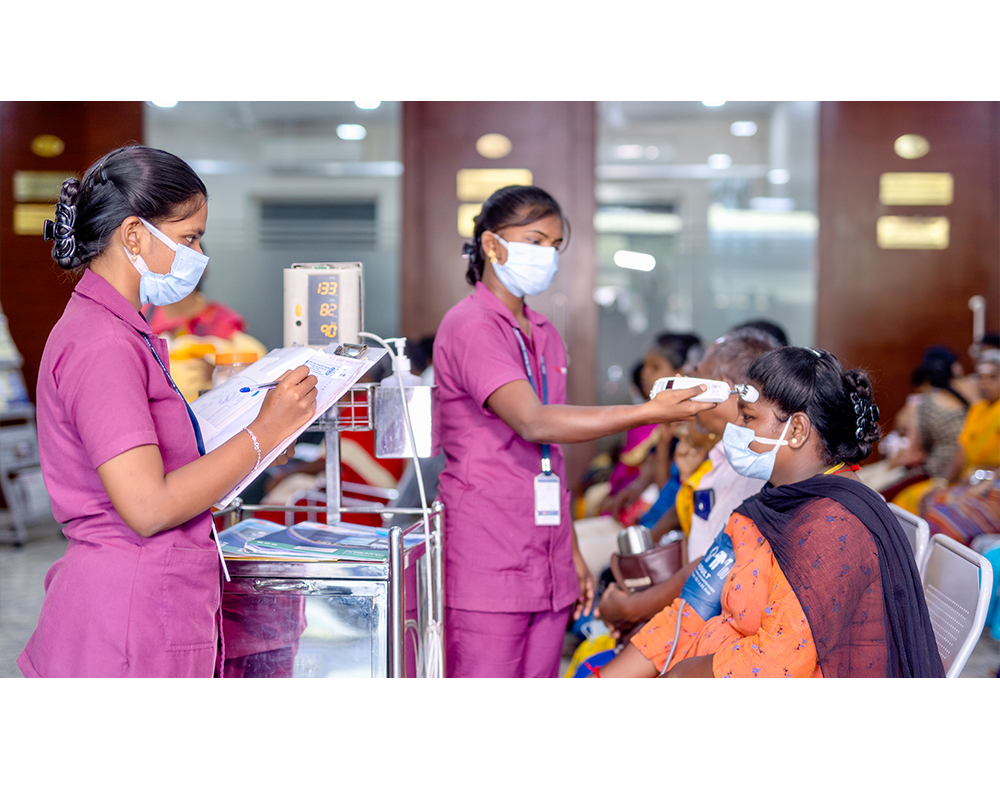- Home
- About Us
- Services
-
Doctors
- Departments
- Anaesthesiology & Critical Care
- Internal Medicine & Diabetology
- Surgical Gastroenterology
- Orthopedics & Spine Surgery
- Pediatrics & Neonatology
- Interventional Cardiology
- Dermatology & Aesthetics
- Obstetrics & Gynaecology
- Renal Sciences
- Neurosurgery
- Radiology & Imaging
- Plastic Surgery
- Faciomaxillary & Dental Surgery
- Pulmonology
- Psychiatry
- Surgical Oncology
- Medical Oncology
- ENT
- Pediatric Surgery
- General & Laparoscopic Surgery
- Pediatric Cardiology
- Academics
- Career
- Feedback
- Contact

AMC Super Speciality Hospital
About Us
We bring together state of the art infrastructure, cutting-edge technology and a highly integrated and comprehensive healthcare system along with a quest for exploring and implementing newer therapies/technologies in medicine. AMC Super Speciality Hospital is a tertiary health care provider located near the old bus stand, Tirupur. Since its inception, AMC Hospital has benefited from its dynamic leadership and self-governing administration. Our staff includes a team of expert physicians, surgeons, nurses, and support staff who are committed to providing exceptional medical care to each and every patient. We believe in a patient-centered approach to care, where each patient is treated with respect & compassion.

AMC Super Speciality Hospital
Our Approach
For everyday care or life-changing care, you can count on us to keep your loved ones safe. Our hospital operates outpatient/inpatient/ICU/ER care all under one roof. The focal point of our hospital management team is promoting ethical medicine at an affordable price.
The hospital which started in 2018 as a 50 bedded hospital has evolved to a 120 bedded super speciality hospital in a short span. We have steadly expanded our infrastructure and services since inception. We have evolved to one of the best hospitals in Tirupur in a short span of time due to our impeccable professionalism, transparent pricing policy and system based practice.
We bring together state of the art infrastructure, cutting-edge technology and a highly integrated and comprehensive healthcare management system.
We are serving people not only from the city of Tirupur but across the district. We recognize technology plays a vital role in delivering superior healthcare and hence we invest continuously in procuring the best of equipment to serve our patients. AMC Hospital remains at the forefront of technical healthcare excellence.
KODUVAI & GANAPATHYPALAYAM SATELLITE HOSPITALS

Our management team had a strong vision to focus on rural healthcare and establish rural hospitals to address the specific healthcare needs of the local community, prioritize accessibility and collaboration, integrate technology, and focus on patient-centered care in the local region. By aligning our vision with these principles, we established rural hospitals at Ganapathypalayam and Koduvai to provide excellent healthcare services to positively impact the well-being of the community we serve.
The key elements we considered when developing above vision for a rural hospital were to provide :
-
1. Accessible and Comprehensive Care
The vision should prioritize providing accessible healthcare services to the rural population. Ensure that the hospital offers a comprehensive range of services, including primary care, emergency care, specialized care, diagnostic services, and outpatient services. The goal is to provide high-quality healthcare close to home, reducing the need for patients to travel long distances for medical care.
-
2. Community Engagement and Collaboration
Foster strong relationships with the local community and key stakeholders. Engage in open dialogue to understand their healthcare needs, concerns, and priorities. Collaborate with community organizations, government agencies, and healthcare providers to develop a shared vision and garner support for the hospital. Community involvement should be at the core of decision-making processes.
-
3. Cultivate a Skilled and Dedicated Healthcare Team
Assemble a team of healthcare professionals who are passionate about serving rural communities. Recruit physicians, nurses, specialists, and support staff who have experience and knowledge in rural healthcare. Emphasize ongoing professional development and provide opportunities for staff to enhance their skills in rural medicine. Creating a positive and supportive work environment is essential for staff satisfaction and retention.
-
4. Technology and Telemedicine Integration
Incorporate technology and telemedicine solutions to overcome the challenges of limited resources and specialist availability in rural areas. Explore partnerships with tele-health providers and implement electronic health record systems to enable seamless sharing of patient information. Leverage telemedicine to connect patients with specialists remotely, expanding the range of services available locally and reducing the need for patient travel.
-
5. Preventive Care and Health Education
Prioritize preventive care and health education initiatives to promote community wellness and reduce the burden of chronic diseases. Develop programs that focus on health promotion, disease prevention, and early detection. Conduct community health education campaigns, workshops, and screenings to increase awareness and empower individuals to make informed decisions about their health.
-
6. Patient-Centered Care
Place a strong emphasis on patient-centered care, ensuring that patients are treated with dignity, respect, and compassion. Design processes and workflows that prioritize patient needs and preferences. Implement strategies to enhance patient satisfaction, such as shorter wait times, effective communication, and personalized care plans. Create a welcoming and comforting environment that reflects the unique characteristics of the rural community.
-
7. Sustainable Financial Model
Develop a sustainable financial model that considers the unique challenges of operating a rural hospital. Conduct a thorough feasibility study to assess the financial viability of the hospital and explore potential funding sources, including grants, government programs, private partnerships, and community fundraising efforts. Efficient management of resources, careful budgeting, and continuous evaluation of financial performance are essential for long-term sustainability.

AMC Super Speciality Hospital
Our Facilities and Services
AMC Super Speciality Hospital, strives to provide exceptional facilities and services to ensure the highest level of care for our patients. Our state-of-the-art infrastructure encompasses advanced operation theaters, diagnostic imaging centers, and intensive care units, equipped with cutting-edge medical technologies and equipment’s.
Our multidisciplinary departments, staffed by experienced and skilled medical professionals, offer specialized care in areas such as pediatrics, cardiology, neurology, orthopedics, and gynecology, among others. Our 24/7 emergency care department ensures immediate attention and appropriate treatment for critical conditions.
Whether you require inpatient or outpatient services, our comfortable and well-equipped facilities cater to your specific needs. We are committed to delivering personalized and compassionate healthcare that promotes healing and enhances the overall well-being of our patients.
With a team of experienced and skilled medical professionals, we offer specialized care through our multidisciplinary departments.
AMC Super Speciality Hospital
Phone : +91 8 999 777 444Email: info@amchhospitals.com
AMC Super Specialty Hospital
141, Palladam Main Road,
Near Old Bus Stand,
Tirupur, Tamil Nadu – 641 604.
AMC Educational institutions
NH 47, Avinashi Road,
Near Chenniandavar Kovil, Karumathampatti,
Coimbatore, Tamil Nadu - 641 659.
Koduvai
551/B, Dharapuram Main Road,
Koduvai, Tamil Nadu – 638 660.
Ganapathypalayam
TKT Mill to Pongalur Main Road,
Ganapathypalayam, Tirupur, Tamil Nadu – 641 605.
Copyright © 2023 AMC | All rights reserved.



